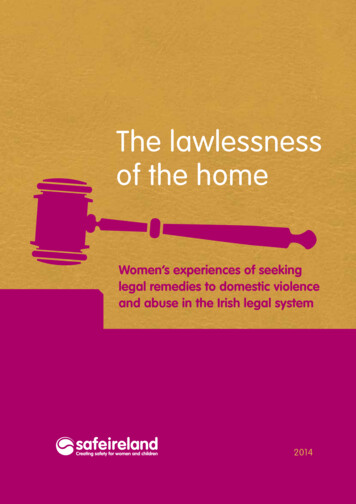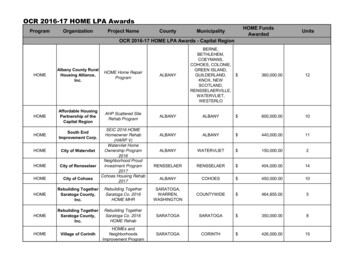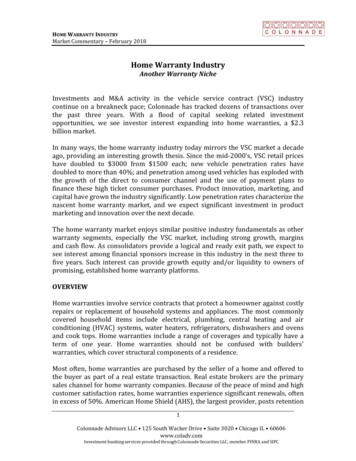
Transcription
The lawlessnessof the homeWomen’s experiences of seekinglegal remedies to domestic violenceand abuse in the Irish legal system2014
ContentsAcknowledgements2Prologue3Rationale for the study7Current context: the enormity of the problemThe Irish legal system and domestic violence79Critique of the Domestic Violence Act 1996 – 200210What about the children?11Government obligations and policy context13Other institutional policies14An Garda Síochána15The Probation Service15International policies responding to domestic violence16Challenges to seeing the gendered nature of domestic violence19Research methodology21Why use first-person narratives?21The desk-based research24The interviews24Language26Narratives of women who have experienced abuse, violenceand the legal system1.The right to be heard2. The consequences of the court not hearing the evidence.High-risk factors: the case of cruelty to animals- The importance of assessing risk272837403. Consistency and continuity in the application of the law41- An analysis of specialist domestic violence court models484. The victim and perpetrator stereotypes- Anti-essentialism and the dangers of the stereotype53565. The importance of good advocacy, expertise and policing596. The need for a legal definition of domestic abuse and violence727.- Definitions of domestic violence around the world74Why she doesn’t just leave – the barriers to safety and help-seeking778. The dangers of a fragmented system – the continued case for amulti-agency approach80‘The lawlessness of the home’Women’s experiences of seeking legal remedies to domestic violence and abuse in the Irish legal system1
Conclusions on domestic violence and the role of the legal system87The rule of law88Agency and autonomy89The legal system’s failure90What we at SAFE Ireland propose to do next91Closing knowledgementsSAFE Ireland is pleased to present this important research report. It was made possible by the lead co-ordination and expertiseof the staff and Board of SAFE Ireland. Special thanks must be given to Simone George who researched the project andinterviewed the women. Our interns Linda Kenna, who conducted extensive desk research and Shauna Markey who workedwith the transcripts, editing and who generally provided much valued input throughout the project. We are very grateful alsoto Mary Ronayne, Siobán O’Brien Green and Rachel Smith for their valuable contribution at different stages of the researchproject. This research was further strengthened by the critical engagement of our member organisations who worked to identifyand support women to participate in the research, who contributed valuable expertise in interviews and/or who participatedin the national consultation workshop. To the many readers and editors thank you, your input enabled us to shape the finalreport. Finally, we would like to thank the women who came forward to tell their stories, what happened to you was wrongand should never have happened but your courage to speak and share your insights has made a difference in the worldalready, thank you.2‘The lawlessness of the home’Women’s experiences of seeking legal remedies to domestic violence and abuse in the Irish legal system
PrologueI was in a small room I had never been in before, in a west of Irelandtown I had never been to before, yet the room was familiar, beingso similar to others I had been in around the country. Some roomswere smaller, some had no window, or the curtains were permanentlydrawn because they faced the street. But they all had the sameborrowed, mismatched furniture, a corner with a box of well-usedchildren’s toys and books, and the feeling that someone had tried tomake them comfortable. The room in this refuge was different in oneway - it had some wardrobes, perhaps allowing it to double-up as abedroom when the refuge was full.It was late afternoon and I had half an hour before the third womanthat day came to talk to me. I sat on the small couch staring atthe wardrobe doors listening through the pulled curtains to childrenplaying on the swing set outside. From where I was sitting I couldsee above the wardrobes and into four clear plastic boxes. Each wasmarked: ‘baby clothes’; ‘women’s skirts’; ‘women’s tops.’ The finalbucket was marked ‘shoes.’ In it were sandals, flip-flops, runners and Icould not understand why there was a box of shoes. Why would theyneed shoes? And, then I realised – they need a box of shoes becausesome women leave their homes barefoot. They leave in the middle ofthe night or they leave in a moment when they can see nothing elseother than leaving. They don’t think about the consequences. Theydon’t even stop to put their shoes on.I am telling you the story above, over all the others I could tell, for a reason. Although I had heardnine first-hand accounts of abuse and violence and would go on to hear more, that realisation, thatconnection my mind made, gave me an insight into the dynamics of abusive relationships.SAFE Ireland asked me to work with them and their member services, reviewing the legal system’sresponse to domestic abuse and violence. We listened to and transcribed women’s accounts of theirexperience of the legal system, we recorded domestic violence services’ accounts and we reviewedthe academic research on the subject. This report is the culmination of many people’s work, butI chose to tell the story about the box of shoes from my perspective because I am learning thatwomen’s experience of domestic violence depends also on the experience of those who meetthem: their communities, larger society, the media, the Garda who are called to the house, the localdomestic violence service advocate giving refuge and support, the lawyer advising her and the judgehearing the case.‘The lawlessness of the home’Women’s experiences of seeking legal remedies to domestic violence and abuse in the Irish legal system3
PrologueI had heard heart-rending accounts of abuse and accounts of the failings and successes of our legalsystem in protecting the rights of these women. But it was the box of shoes that provided the illustrationI needed to begin to understand what I was hearing. I had to see the individual and the consequencesshe faced if she left, as much as the consequences for her if she stayed. I had to see beyondthe perpetrator and victim, to the violence and the abuse as acts in isolation that require society’sintervention and assistance. At times the accounts were so dark and apparently hopeless that my mindhad no file for what I was hearing and therefore on some level I couldn’t believe what I was hearing.It is in fact fantastical that your husband fills your petrol tank with a pint bottle in order to control howfar you can drive, that this is happening in the small country town where you were born and raised. Itis cliché, it cannot be true, it is what we understand only as fiction that the law leaves these womentrapped hiding in wardrobes, insists that children spend time unsupervised with a parent proven to beabusive or violent. I wonder whether people who experience cruelty like this at the hands of a lovedone in their home, themselves don’t believe it happened, even though they heard the words, wereunder the control, or covered up the bruises.We need to start assessing the pattern of abusive acts, toisolate the behaviours and judge them. We need to work atnot being blinded by our own experience of life and judgementof individuals’ choices, to see and hear each individual as an“Until everyone is safe,individual. We have to understand the real consequences ofno one is safe.”leaving an abusive relationship; if we don’t understand them wedon’t address them and we can’t ensure those consequencesNational Network to End Domestic Violence,USA, 24-Hour Census 2013aren’t the reason that they decide to stay. How will I feed mychildren? Where will we live? I can manage the abuse. How willI manage access and maintenance and the courts? Now thathe has lost control over me and has nothing to lose, will he kill me? Will he kill our children?And we have come so far in such a short time; 40 years ago, there was no refuge from domesticviolence, no services, no national network of services. Acknowledgement of domestic abuse andviolence as occurring at all and its requiring society’s and the state’s intervention is relatively new. Untilthe 1970s, there was often no response at all and it was not ‘society’ generally that demanded theseinterventions, but grassroots activists. The first service in the modern world was opened in Chiswick inBritain in 1971, by the organisation known today as Refuge. The first refuge in Ireland opened in 1974and the first domestic violence legislation followed in 1976, providing the courts with the power tomake barring orders for the first time. In Ireland, marital rape was criminalised only in 1990.The key goal of the battered women’s movement has been to create options for women seeking havenfrom abusive relationships1. Leigh Goodmark writes that shelters were soon followed by advocacy foreffective civil and criminal justice interventions and that the growth in legal responses to domesticviolence has been spurred over the last decade. Despite this, domestic violence rates in the US havenot appreciably declined, instead keeping pace with decreases in the crime rate generally. This wouldhold true in Ireland also and this report will look at some key statistics from Ireland in some detail.4‘The lawlessness of the home’Women’s experiences of seeking legal remedies to domestic violence and abuse in the Irish legal system
PrologueWhile we should not expect the legal system to be a panacea, throughout the world it has becomethe default response to domestic violence2. And so this report is a step towards assessing the efficacyof its response. Its intervention at all was a massive step forward for Irish society. But, as this report willshow, those who do engage with the Irish legal system do so with very mixed results. Still relatively fewwomen report domestic violence to police. Most domestic violence perpetrators are not convicted andwhen they are convicted, jail time is rare. It must be noted that this research could not capture thosewho are denied justice because they are unable or unwilling to engage with the legal system.At this point it is important to think of the legal system as two parts – firstly, the law itself, the legislationapplicable to domestic violence and, secondly, the actual, practical application of that law; policy andpractice, rules and enforcement. The legal system’s failure to comply with existing law is a repeatedtheme in the women’s narratives that are the backbone of this research and report.When we don’t provide for the consequences of leaving a violent and abusive relationship by providingsafe shelter, or removing the threats of homelessness, physical harm and poverty from women’sdecision-making, we tacitly condone violence against them. We also encourage and justify those whobeat, abuse and control them. Abuse by a family member inflicted on another who is consequentlyless able to defend themselves is a violation of the most basic human rights. It is a violation of theconditions of civilised society, of Irish society: the right to live in physical security, free from the fear thatbrute force will determine the conditions of daily life3. When those who live with abuse ask the legalsystem to intervene and it does so inadequately, it in turn violates their rights.Those women affected by domestic violence are a diverse group of women, with unique and individualcharacteristics and coping mechanisms, which requires us to think in a more sophisticated way aboutthe attributes and needs of women who experience violence and abuse4. The legal system is the mostdeveloped and best-funded response to domestic violence but it does not appear to understand andtherefore respond to the particular needs of individuals before it. And relying on the legal system hasenabled us, as a society, to believe that something has been done about domestic violence. Reform ofthe Irish legal system could solve some of the problems of responding to each individual case, but wehave to be brave enough to completely re-think how we address domestic violence generally.Simone George, Solicitor, SAFE Ireland Researcher‘The lawlessness of the home’Women’s experiences of seeking legal remedies to domestic violence and abuse in the Irish legal system5
6‘The lawlessness of the home’Women’s experiences of seeking legal remedies to domestic violence and abuse in the Irish legal system
Rationale for the studyRationale for the studySAFE Ireland is the national representative for 40 domestic violence support services in Ireland, leadingon research and dissemination of good practice to its members, other professionals and statutorybodies. The organisation collates the experience of member services and gives them and the survivorsa public voice, sharing the experiences and the enormity of domestic violence in our country. Membersof SAFE Ireland have heard of women’s struggles with the legal system from all over the country andthe difficulties they face in securing protection from domestic violence for themselves and their children.SAFE Ireland services have continuously reported on the barriers and issues that women face whilenavigating the system seeking justice. Now is the time that these issues, that have let so many down,be examined and addressed. We must give voice to the women who have been silenced by the failuresof our legal system. The enormity of the problem of domestic violence in Ireland reinforces the needfor us all to examine how we deal with it. Each year thousands of women flee their home with theirchildren to escape violence, and the Irish government and people must be responsible for providingthose women with an effective remedy.Critique of the Irish legal system and how it deals with domestic violence was forthcoming as far backas 1995 and much of it still holds today. The Law Reform Committee; Rosemary Horgan; Eileen Glynn;Genevieve Coonan; Patricia Kelleher; Monica O’Connor; Claire Hogan and Sinead Kelly are among thosewho have examined the way in which the Irish system works and where the system fails. They haveoffered recommendations to better the experience and outcomes for victims of domestic violence. Theirwork has highlighted the issues rampant in the system and brought attention to the flaws of a systemwhich urgently needs to be addressed. SAFE Ireland acknowledges that their work encouraged furtherexploration of the legal system and gave public voice to the women who have had experience with itas they seek protection from domestic violence.Current context: the enormity of the problemThe World Health Organisation (WHO) has described violence against women as a “global healthproblem of epidemic proportions.”5 The WHO’s ‘Multi-Country Study on Violence Against Women’ foundthat prevalence figures of women ever physically abused by a male partner ranged from 15% in Japanto 71% in Ethiopia. On average they maintain that 30% of the world’s women that have been in arelationship have been sexually or physically abused by their intimate partner6. Domestic violence isrampant in all countries worldwide regardless of culture and class. When we focus on Ireland, thenumber of women and children who have lived with and continue to live with domestic violence istruly shocking, disturbing and sad.The SAVI (Sexual Abuse and Violence in Ireland) report found that 23% of sexual assaults occurring inIreland are by an intimate partner7. According to research carried out by the European Union Agency forFundamental Rights8, 31% of Irish women surveyed had experienced some form of psychological abuseby a partner since the age of 15. This equates to nearly one in three women in Ireland who have beensubjected to controlling behaviour by a partner; economic violence; abusive behaviour; or threateningbehaviour. 26% of women surveyed in Ireland had experienced physical/and or sexual violence by apartner or non-partner since the age of 15. 14% of women surveyed had experienced physical violenceby a partner since the age of 15 and 6% of women had experienced sexual violence by a partner sincethe age of 15.However, the actual number of women who continue to live with domestic violence is unknown;the majority of women never report the violence or seek assistance. The EU FRA study9 also focused‘The lawlessness of the home’Women’s experiences of seeking legal remedies to domestic violence and abuse in the Irish legal system7
Rationale for the studyon the services that women contacted for help following the most serious incident of violence by apartner; 21% of Irish women went to the police; 20% went to hospital and 24% of women went to adoctor or other health care professional. Only 8% of women went to a women’s shelter. SAFE Irelandannual statistics 2012 revealed that 8,449 women and 3,606 children received support from a domesticviolence service. SAFE Ireland member domestic violence services across the country provide a range ofinformation, support and advocacy services to women and children experiencing or at risk from violence,abuse and control, every day of the year. These services include safety, information, emotional andpractical support, aftercare, support groups, transitional housing, court accompaniment and children’sservices. There are 20 dedicated refuges that provide essential emergency accommodation to womenand their children looking for immediate safety. Victims of domestic violence have wide-ranging supportneeds. A core part of working with women and children to address their safety needs and the impactof domestic violence, involves SAFE Ireland member services having to navigate and respond to anarray of legal, migration, housing, funding and language issues which a woman will present with to adomestic violence service.Respondents to the FRA study were asked to cite the reasons for not contacting the police for assistance.53% of women stated that they dealt with it themselves/involved a friend/family member. The reason forsuch a response may be connected to the shame and embarrassment which 16% of Irish respondentscited as reasons for not reporting. Similarly 22% of Irish women said that they did not want anyone toknow and wanted to keep it private, while 18% of women feared offender reprisal and 7% of womenrevealed that they had been discouraged or stopped from reporting the incident. 13% thought theincident was too minor to bring attention to. 9% of women surveyed did not want the offender to bein trouble and 8% did not want the relationship to end. 8% of Irish women believed the police wouldnot do anything while 6% of women felt the police could not do anything about the incident. 8% ofwomen believed the incident was their own fault and 5% thought they would not be believed by policeif they reported the abuse. 4% cited that someone else had reported the incident. 2% of women wentsomewhere else for help. And, 3% of Irish women surveyed were afraid that they would lose theirchildren if they reported the abuse to the police.When asked for the reasons for not contacting services other than the police, responses were similar. 70%of women said they dealt with it themselves/involved a friend/family member. Shame, embarrassment(17%) and wanting to keep it to themselves (21%) ranked high among reasons for not accessing otherservices. 14% of Irish women surveyed said that they thought the incident was too minor to seek help;4% believed the abuse was their own fault; 3% were afraid that they would be blamed, and 2% fearedthat they would not be believed. 10% of women cited fear of the offender as a reason for not seekingassistance; 11% were too emotionally upset to seek help, and 9% of women did not know where toturn to. 2% of Irish women were stopped or discouraged from looking for help.However, differing from the reasons given for not contacting the police, 2% of women said that therewere no services available, 5% stated that services were too far away or hard to get to and 7% of Irishwomen cited not being able to afford a service as a reason for not seeking help. We know from Safetyin a Time of Crisis10 that the demand on services is increasing year-on-year, with resources afforded tothese services being reduced consistently for the past number of years. Issues such as the reductionin rent allowance; the increased legal aid fee; and overall reductions in payments from the Departmentof Social Protection have posed real barriers to women accessing the supports they need to escapeviolence. A system that cannot ensure that a woman’s needs will be met and her safety assured deterswomen from coming forward, leaving them and their children at high risk living with a violent partner.8‘The lawlessness of the home’Women’s experiences of seeking legal remedies to domestic violence and abuse in the Irish legal system
The Irish legal system and domestic violenceThe Irish legal system anddomestic violenceThe Irish legal framework on domestic violence is mostly contained in the Domestic Violence Act 1996- 2002. The 1996 - 2002 Act provides for a civil remedy to protect victims from domestic violence. Theonly criminal element of the Act applies to a breach of an order.Other criminal law pertaining to domestic violence and the protection of victims can be found in thefollowing pieces of legislation: Non-Fatal Offences against the Person Act 1997; Criminal Law (Rape)Amendment Act, 1990; Guardianship of Infants Act, 1964; Children Act 2001.Domestic Violence Act, 1996 and Domestic Violence (Amendment) Act,2002The Domestic Violence Acts, 1996-2002 grant relief for spousal misconduct and domestic violence11.The act provides civil remedies to protect individuals from domestic violence. The Domestic Violence Act,1996 (as amended) was introduced to perform three functions:1) To protect spouses, children and other dependent persons and persons in other domesticrelationships where the threat to their safety or welfare is at risk because of the conduct of theother person in the domestic relationship;2) To increase the powers of An Garda Síochána to arrest without warrant; and3) To provide for the hearing at the same time of applications to court for other orders regardingcustody and access, maintenance, conduct leading to the loss of the family home, restriction onthe disposal of household chattels, and child care orders12.The Act provides for a number of remedies to assist victims of domestic violence. These include: barringorder, which removes the offender from the residence and also prohibits the person from furtherviolence or threats of violence, and from watching or being near the home; interim barring order,which can be granted until a full hearing can be heard; protection order, which orders the respondentnot to use violence or threaten to use violence against, molest or put in fear the applicant or anydependent person and can be made ex parte13; safety order, which prohibits the violent person fromfurther violence or threats of violence.Sanctions for contraventionA respondent who breaches any of the conditions of the orders enumerated above or, in respect of abarring order or interim barring order, who refuses to permit the applicant or any dependent person toenter in and remain in the place to which the order relates or does any act for the purpose of preventingthe applicant or such dependent person from so doing shall be guilty of an offence under Section 17 ofthe Act and liable on summary conviction to a fine not exceeding 1,904.61 or imprisonment for aterm not exceeding 12 months. The penalties for breach of the barring order will be clearly stated onthe order14.Section 18(2) of the Act provides for additional powers of arrest for the Gardaí where they have reasonablecause to believe that a person is being assaulted (occasioning actual bodily harm, malicious woundingor inflicting any grievous bodily harm) and the person is someone who could apply for a safety orderor a barring order15. Under this Section the Garda may enter, if need be by force, and search any placewhere he suspects the respondent to be without obtaining a warrant16.‘The lawlessness of the home’Women’s experiences of seeking legal remedies to domestic violence and abuse in the Irish legal system9
The Irish legal system and domestic violenceCritique of the Domestic Violence Act 1996 - 2002Commentators on the Domestic Violence Act 1996 have expressed concerns over multiple aspects ofthe Act. Those aspects which garner the most concern include – the issue of ex parte applications; therequirements for the granting of an order; including the residence of an applicant; and the limitationson what individuals are entitled to a protective order.The lack of statutory guidance in granting ordersUnder the 1996 Act, the court must be of the opinion that there are reasonable grounds for believingthat the safety or welfare of the applicant or any dependent person requires a protective order to bemade17. Nestor has noted that the definition of ‘welfare’ in the 1996 Act does not require the court totake any specific criteria into consideration when making protective orders18. He goes on to argue thatthe absence of any statutory guidance surrounding the concept of welfare renders the application oflaw uncertain and therefore creates difficulties for solicitors advising their clients19. Horgan has alsoexpressed regret that there is not more guidance contained in the legislation for the granting of orders20.This opportunity for discretion has proven itself to be problematic for women and is evident from ourresearch.Further statutory guidance needs to be provided regarding the standard of proof necessary to establishabuse. This lack of statutory guidance has led to a variation of practices between district court areas.This is illustrated through data from the Law Reform Committee where 72% of respondents to thesurvey indicated that allegations are generally supported by the evidence of the applicant alone, with26% indicting that evidence of the applicant and medical evidence is always required and 2% replyingthat medical evidence is always required21. In non-violent cases involving emotional abuse, neglector addiction, 59% indicated that the abuse is generally supported by evidence of the applicant alone,with 22% stating that both the evidence of the applicant and medical evidence are required and 18%noting that medical or other evidence is always required in such cases22. This data illustrates the lackof uniformity in court practice, rendering the application of law uncertain, making cases difficult for boththe lawyers and their clients.Ex parte granting of ordersReviews of the protective orders available to individuals to protect from domestic violence and therequirements for obtaining these orders reveal the apprehension that surrounds them. For example, inexceptional cases interim barring order applications may be made ex parte23. Commentators pointedout that this provision had the potential to render injustice unless a speedy return date was given forthe hearing of the case24. The District Court (Domestic Violence) Rules 199 provide that a return datefor the hearing of the full application be inserted into the body of the interim barring order. The powerto grant such orders is considered to be an excellent device for the protection of victims of domesticviolence25.Also in relation to ex parte interim barring orders the Law Reform Committee recommends that thedistrict court rules be amended to require that ex parte applications for a protection order or an interimbarring order be made on affidavit and that the respondents automatically be provided with a note of allthe evidence given at a hearing. It also proposes that personal service of the barring summons shouldbe required in all cases or at least where the respondent is barred ex parte26.The grounds required for the granting of ordersHorgan highlights the deficiency in the Domestic Violence Act 1996 as amended of not being availableto certain individuals, such as persons affected by a decree of nullity, cohabitants who do not satisfy10‘The lawlessness of the home’Women’s experiences of seeking legal remedies to domestic violence and abuse in the Irish legal system
The Irish legal system and domestic violencerequirements, adult siblings who want a barring order, and finally where property is owned by an adultchild the court cannot bar such a child. All other categories of applicants should be protected under thelegislation. Once violence occurs in a domestic situation it follows that relief should be available underdomestic violence legislation. Equivalent legislation was introduced in Britain to tackle this problemwhere they developed the concept of ‘associated persons.’ In this way British legislation covers a largercategory of persons entitled to apply for either an occupation order or a non-molestation order27.The Law Reform Committee recommends that the residence requirement be removed for cohabiteesseeking a safety order and for cohabitees with sole ownership or tenancy rights in the home seekinga barring order. It also proposes the introduction of provisions permitting parents or elderly relations toapply for protective orders against abusive relations or persons other than an adult child. These shouldinclude safety or barring orders against such relations or persons residing in the home and safety ordersagainst those residing elsewhere28.It also proposes the introduction of a category of associated persons who are entitled to apply fora safety order and the provision of a non-exhaustive list of persons to include those affected by orpending decree of divorce and non-cohabitees with a child in common. Also, associated persons withsole ownership or tenancy rights in the home should b
is cliché, it cannot be true, it is what we understand only as fiction that the law leaves these women trapped hiding in wardrobes, insists that children spend time unsupervised with a parent proven to be . 40 years ago, there was no refuge from domestic violence, no services, no national network of services. Acknowledgement of domestic .










